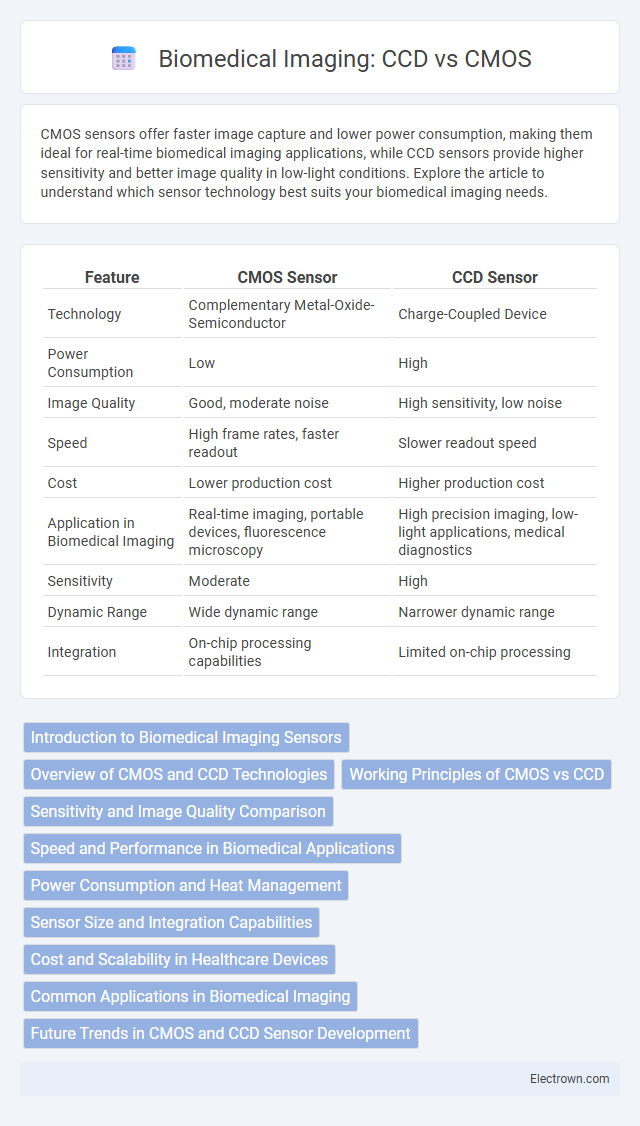CMOS sensors offer faster image capture and lower power consumption, making them ideal for real-time biomedical imaging applications, while CCD sensors provide higher sensitivity and better image quality in low-light conditions. Explore the article to understand which sensor technology best suits your biomedical imaging needs.
Table of Comparison
| Feature | CMOS Sensor | CCD Sensor |
|---|---|---|
| Technology | Complementary Metal-Oxide-Semiconductor | Charge-Coupled Device |
| Power Consumption | Low | High |
| Image Quality | Good, moderate noise | High sensitivity, low noise |
| Speed | High frame rates, faster readout | Slower readout speed |
| Cost | Lower production cost | Higher production cost |
| Application in Biomedical Imaging | Real-time imaging, portable devices, fluorescence microscopy | High precision imaging, low-light applications, medical diagnostics |
| Sensitivity | Moderate | High |
| Dynamic Range | Wide dynamic range | Narrower dynamic range |
| Integration | On-chip processing capabilities | Limited on-chip processing |
Introduction to Biomedical Imaging Sensors
Biomedical imaging sensors, primarily CMOS (Complementary Metal-Oxide-Semiconductor) and CCD (Charge-Coupled Device), play a crucial role in capturing high-resolution images for medical diagnostics. CMOS sensors offer advantages like lower power consumption, faster readout speeds, and on-chip integration, making them suitable for real-time biomedical imaging applications. In contrast, CCD sensors provide higher sensitivity and lower noise levels, which are essential for capturing precise and detailed images in clinical settings.
Overview of CMOS and CCD Technologies
CMOS (Complementary Metal-Oxide-Semiconductor) and CCD (Charge-Coupled Device) sensors are pivotal in biomedical imaging, each offering distinct technological advantages. CMOS sensors provide high-speed image capture, low power consumption, and integrated circuitry, enabling compact and cost-effective imaging systems. CCD sensors excel in image quality with high sensitivity and low noise, making them ideal for applications requiring precise and detailed biomedical image acquisition.
Working Principles of CMOS vs CCD
CMOS (Complementary Metal-Oxide-Semiconductor) sensors convert light into electrical signals using active pixel sensors with individual amplifiers for each pixel, enabling fast readout and low power consumption. CCD (Charge-Coupled Device) sensors transfer charge across the chip to a single output node, resulting in high sensitivity and low noise but slower readout speeds. Your choice between CMOS and CCD in biomedical imaging depends on the specific requirement for image quality, speed, and power efficiency.
Sensitivity and Image Quality Comparison
CMOS sensors in biomedical imaging typically offer higher sensitivity due to lower noise levels and faster readout speeds compared to CCD sensors, resulting in improved detection of low-intensity signals. CCD sensors, while known for superior uniformity and lower fixed-pattern noise, often exhibit slower readout times that can limit real-time imaging applications. Overall, CMOS technology provides enhanced image quality in fast, high-resolution biomedical imaging tasks, whereas CCD remains valuable in situations requiring high dynamic range and precise image uniformity.
Speed and Performance in Biomedical Applications
CMOS sensors offer faster readout speeds compared to CCD sensors, making them ideal for real-time biomedical imaging applications such as live cell monitoring and surgical guidance. The superior speed of CMOS technology enhances temporal resolution, enabling precise capture of rapid physiological processes and dynamic cellular events. CCD sensors, while traditionally known for higher image quality, lag behind CMOS in frame rate and low-latency performance critical for time-sensitive biomedical diagnostics.
Power Consumption and Heat Management
CMOS sensors generally consume less power and generate less heat compared to CCD sensors, making them more suitable for biomedical imaging devices that require prolonged operation and minimal thermal interference. Lower heat production in CMOS sensors helps maintain sample integrity and improves image stability by reducing thermal noise during acquisition. Your biomedical imaging system can benefit from CMOS technology by enhancing energy efficiency and ensuring reliable heat management for accurate diagnostic results.
Sensor Size and Integration Capabilities
CMOS sensors offer smaller sizes and higher integration capabilities compared to CCD sensors, making them ideal for compact biomedical imaging devices. Their ability to integrate additional circuitry on-chip enables faster processing and lower power consumption essential for portable or wearable medical diagnostics. Your choice of sensor directly impacts the imaging system's form factor and performance in clinical environments.
Cost and Scalability in Healthcare Devices
CMOS sensors offer significant cost advantages over CCD sensors due to lower manufacturing expenses and simpler integration processes, making them ideal for scalable production in healthcare devices. Their ability to be fabricated using standard semiconductor processes enables mass production, reducing the price of biomedical imaging systems and facilitating widespread adoption. Your healthcare solutions can benefit from CMOS technology's scalability, providing affordable, high-quality imaging essential for diagnostics and patient care.
Common Applications in Biomedical Imaging
CMOS sensors are widely used in real-time biomedical imaging applications such as endoscopy and fluorescence microscopy due to their high frame rates and low power consumption. CCD sensors excel in applications requiring high sensitivity and low noise, including digital pathology and retinal imaging, providing superior image quality for detailed diagnostics. Your choice between CMOS and CCD will depend on specific needs like imaging speed and sensitivity in biomedical research or clinical settings.
Future Trends in CMOS and CCD Sensor Development
CMOS sensors are rapidly advancing with improved low-light sensitivity and faster readout speeds, making them increasingly suitable for dynamic biomedical imaging applications. CCD technology continues to evolve with enhanced noise reduction and higher quantum efficiency, benefiting high-precision diagnostic tools. Your choice between CMOS and CCD will depend on future sensor performance improvements aligned with specific biomedical imaging requirements.
CMOS vs CCD in Biomedical Imaging Infographic

 electrown.com
electrown.com